on ADT Security System's website
ADT Home Security Review 2025: Cost, Pros, Cons
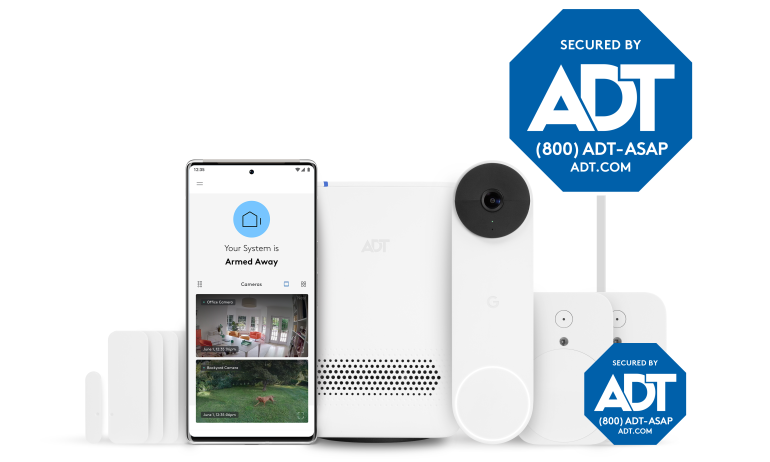
Some or all of the mortgage lenders featured on our site are advertising partners of NerdWallet, but this does not influence our evaluations, lender star ratings or the order in which lenders are listed on the page. Our opinions are our own. Here is a list of our partners.
ADT is a home security provider that offers DIY and professionally installed alarm systems and cameras. The company’s long-term contracts can feel restrictive, but the benefits can be worth it for customers looking for a professionally installed and monitored system from a household name.
ADT has been operating for more than 150 years, making it one of the most well-known names in home security. The company now integrates its alarm systems with Google Nest cameras, video doorbells and smart home devices.
Pros | Cons |
|---|---|
Operates six U.S.-based professional monitoring centers, leading to fast alarm response times. | Required monthly monitoring fees for all plans, ranging from one month to three to five years. Monitoring fees are high compared to other providers. |
Offers both DIY and professionally installed systems. | Had a security breach in 2020 that affected customers in the Dallas-Fort Worth, TX area. |
Integrates with Google Nest devices and can connect with Alexa and Google Assistant for voice control. | Integrating ADT equipment with Nest products can be complicated and involved using several different apps in our experience. |
Our take: Overall, ADT packages are on the expensive side for what you get compared to other providers, especially for DIY packages and basic equipment, but the company’s tried-and-true professional monitoring makes their pro-install system a good pick for homeowners.
Deciding factors | |
|---|---|
One-time costs | Packages start at $269 (list price) for a base hub and a door/window sensor. |
Monthly fees | $24.99 and up. |
Installation | Professional install and DIY options. Pro installed systems start at $449 with a required monitoring contract starting at $34.99 per month. |
Video monitoring |
All monitoring plans are $10 more per month with a professionally installed system. |
Contract | 36-month minimum for professionally installed system; 24 months in California. |
How does ADT work?
To purchase an ADT system, you visit the company’s website and select a package.
Pro install
If you choose professional installation, you’ll schedule an appointment for an ADT technician to come to your home and set up the equipment. Appointments may be available as soon as the next day.
A professionally installed ADT system comes with a required professional monitoring contract, typically three years, starting at $34.99 per month.
DIY
If you choose DIY, ADT will mail your equipment and you’ll follow the instructions provided in the included setup guide. If you need extra help, you can consult ADT’s virtual assistant online. DIY systems require at least one month of professional monitoring, starting at $24.99 per month.
After the first month, you can call ADT to downgrade to free self-monitoring. Be sure to cancel your plan before the billing cycle ends, though, or you may be charged for a full second month.
How much does ADT cost?
ADT offers six home security system packages, which can be DIY or professionally installed, and a build-your-own-system option. The company frequently offers promotions, including discounts on self-setup packages with one month of professional monitoring, and professionally installed packages with a three-year professional monitoring contract (two years in California).
The prices below are list prices.
Package | Price | What you get |
|---|---|---|
Security Starter | $349 | Base hub, 3 door/window sensors and motion sensor. Requires a $29.99 monthly plan. |
Life Safety | $404 | Base hub, 2 door/window sensors and a smoke/CO detector. Requires a $24.99 monthly plan for DIY or $34.99 monthly for pro install. |
Video Essentials | $529 | Base hub, 3 door/window sensors, motion sensor, and a Google Nest camera or doorbell. Requires a $39.99 monthly monitoring plan for DIY or $49.99 monthly for pro install. |
Outdoor Video | $649 | Base hub, 2 door/window sensors and a battery-operated Google Nest camera. Requires a $39.99 monthly monitoring plan for DIY or $49.99 monthly for pro install. |
Front Door Protection | $719 | Base hub, 3 door/window sensors, motion sensor, smart door lock and Google Nest doorbell. Requires a $39.99 monthly monitoring plan for DIY or $49.99 monthly for pro install. |
Total Safety | $1,574 | Base hub, 3 door/window sensors, motion sensor, smoke/CO detector, wired Google Nest camera, battery-operated Google Nest camera, Google Nest floodlight camera, Google Nest doorbell, smart door lock and 3 water/temperature sensors. |
You can also create a custom system. The lowest-priced package possible includes an ADT base hub and one door/window sensor for $269, and you can add on any ADT or Google Nest devices from there. You can also add on items to customize any existing package.
Our experience with ADT
We first tested ADT products in June 2024. ADT has made some changes in the past year, so we re-tested the ADT and Google Nest product suite to see how it compares to our other top home security system picks.
ADT sent us a package that included the ADT “Base,” two door/window sensors, a motion sensor, a glass break sensor, a smoke/CO detector, a water and temperature sensor, a Nest doorbell, a battery-powered Nest Cam, a wired indoor Nest Cam, a Yale smart lock and a wireless smart light dimmer. Here’s what we thought.
What we liked
New device appearance
All of the devices we tested were even more streamlined-looking than the last version, making them blend in well with our doors and walls. ADT devices were all fully white, and Nest cameras were black and white. There’s even an invisible keypad on the top of the Base, so numbers and icons don’t show unless they’re lit up for a specific reason.
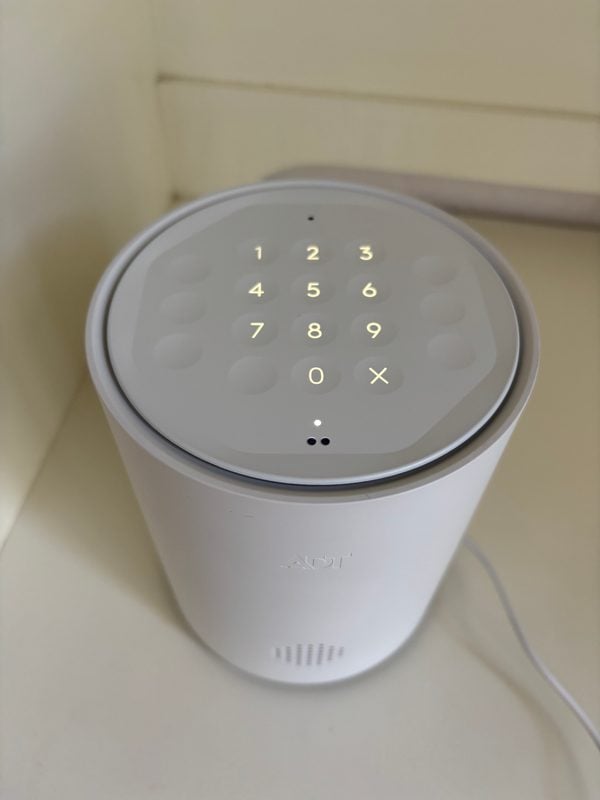
Image by Dalia Ramirez.
Easy device setup
The hub had very clear setup instructions, and it’s easy to add accessory devices with the ADT app. You follow detailed, step-by-step instructions in the app, including pulling a paper tab to activate the battery already included inside. While connecting, the device and the Base show blue lights, and when they’re connected successfully, the Base dings and lights up green. The app’s setup instructions include placement recommendations for best functionality.
Practice mode
With a professional monitoring plan, your system will be in “practice mode” for the first seven days so that you can practice triggering alarms and receiving alerts without the monitoring center contacting emergency services. We found this feature helpful in testing out the system. Several other providers have a similar feature. You can also switch to test mode anytime in the app for up to 24 hours.
Easy to arm and disarm
We were able to arm and disarm our system with a custom four-digit passcode in the app or on the hub keypad. With a professional monitoring plan, we could also generate a unique verbal passcode to speak to ADT agents in case of an alarm event to verify our identity, which other professionally monitored systems also have (SimpliSafe calls this a “Safeword”). We could also arm and disarm the system in the ADT+ app, using Face ID, which made controlling the system much easier.
Alert customization
ADT automatically sends phone alerts in the event of an alarm or system failure, but you can customize any additional alert to be triggered by a specific sensor action or event, such as a user entering the home network. You can even set the alert to only notify specific users and operate at custom times.
For example, you can customize an alert to send you a push notification when your kid comes home from school that’s only in effect on weekday afternoons. Outside of that window, you won’t get a text message when that user enters or leaves the home. There’s even a feature that sends an alert if nothing happens during the timeframe, so you would get a text if your kid wasn’t home by 4:00.
Customer service
Each time we contacted customer service during our testing (to inquire about shipment delays, to verify pricing information and to disable professional monitoring after our testing period), we got through to ADT customer service on the phone very quickly, and the agents were helpful, friendly and professional.
Rule automation
We liked that the ADT+ app has a “rules” feature that lets you automate lights, lock doors, and arm the system with triggers specific to your home and schedule. For example, you can set all the doors in your home to unlock at 10 a.m. every Tuesday for your house cleaner.
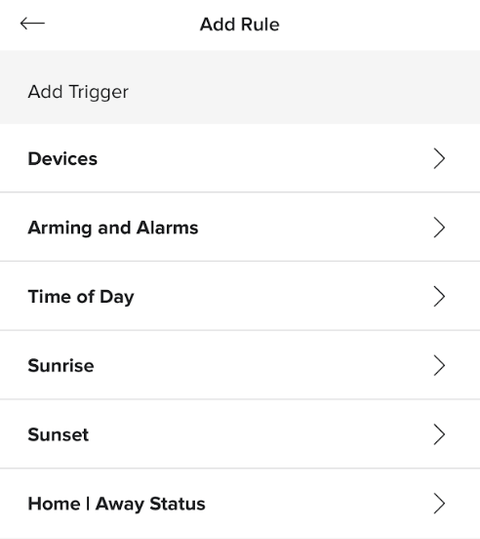
Image by Dalia Ramirez.
What we didn’t like
App bugs
There were a few frustrating moments during our setup process. First, when we left the app, it logged us out and required us to restart the device setup. Also, there were several instances where the app either displayed an error message stating “something went wrong” or froze, but updated without issue after we closed and reopened it.
We also received both push notifications from the ADT+ app and alert texts for each event. We were able to turn off push notifications, but not texts, which is frustrating if you prefer to open push notifications in-app.
Complicated Google Nest integration
Google Nest’s security products can integrate with ADT products — but we found the process complicated. We had to log into a Google account at least four times and enable pages of specific device sharing permissions to fully connect the ADT+ app and the Google Home app. There were several instances where we thought everything had already been connected, but we still had to complete another round of logins.
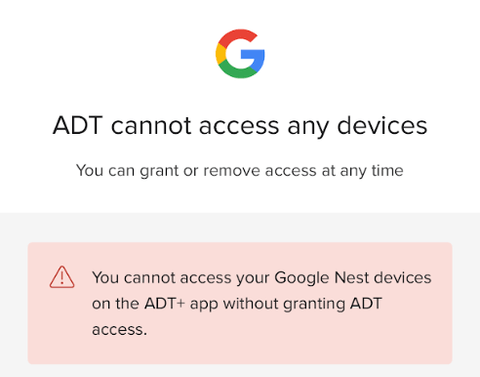
Image by Dalia Ramirez
It was also sometimes unclear which app or device should be used primarily to control the system. For example, we were able to receive push notifications when a Nest camera detected motion from both the ADT+ app and the Google Home app, or neither, but not one or the other. There are also different customization settings in each app; you’ll need to use both to fully customize audio and video preferences.
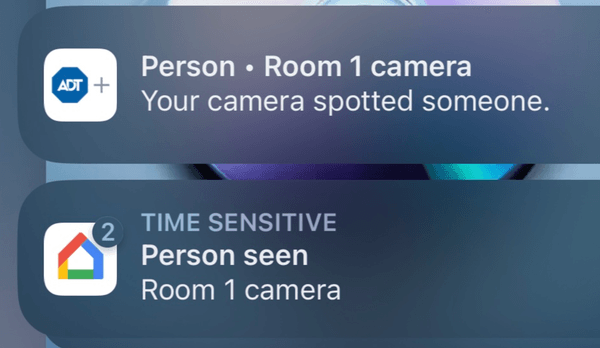
Image by Dalia Ramirez
During our last round of testing, we also had to use the Nest app to connect ADT and Google Nest devices in addition to the ADT+ app and the Google Home app. Google Nest is phasing out this app, and an ADT representative told us in June 2025 that the Nest app is no longer necessary.
Some Nest devices aren’t supported
ADT alarm systems integrate with some Google Nest cameras (mostly newer models) but not all: they won’t connect with the Nest Cam indoor or outdoor (1st gen) cameras, Nest Hello doorbell or Nest Cam IQ cameras.
When Nest Secure, Google’s own home security line, was discontinued in April 2024, former users were given a credit to replace their systems with ADT alarm equipment, but some were likely unable to connect their older-model Nest cameras (which weren’t discontinued) to their new ADT systems.
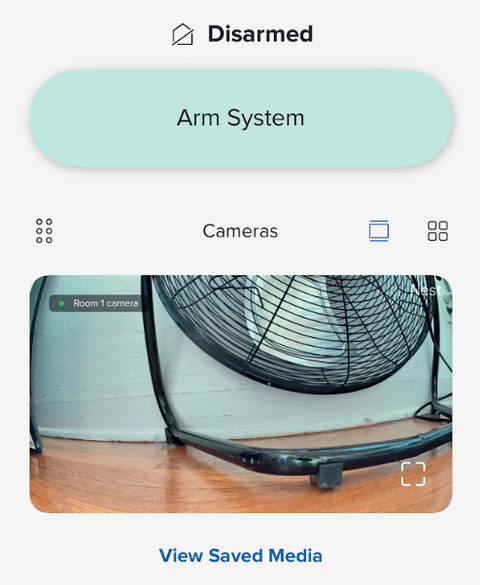
Live feed from Nest camera on the ADT+ app. Image by Dalia Ramirez.
Shipping
We had some issues with delivery timing. ADT emailed a separate contract we needed to sign before receiving equipment, and directed our account to a local representative to activate monitoring services, who we received a text from before receiving any physical equipment.
We also had some issues with delivery for our 2024 review. ADT has well-established professional monitoring and installation capabilities, but we found their DIY process to be less seamless than some competitors.
Alternatives to ADT
on SimpliSafe's website
on Money.com and Amazon.com
on NerdWallet
Read more NerdWallet home security reviews based on firsthand testing:
Methodology












